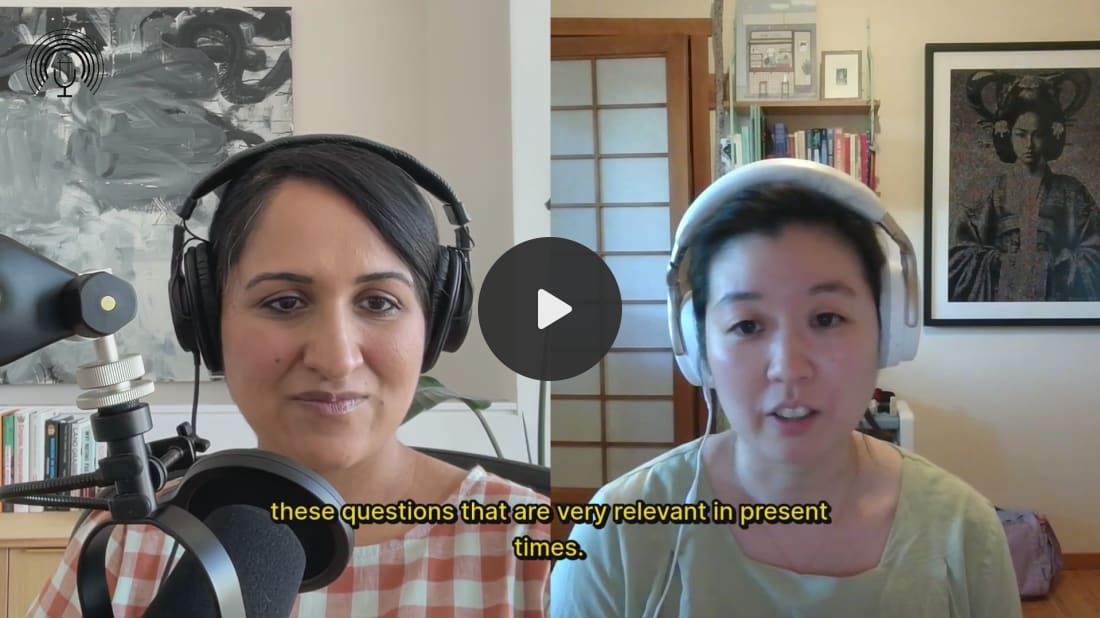Techno-Orientalism & Reimagining Sci-Fi with Elaine U ChoWe explore how techno-orientalism shapes the stories we tell about progress, power, and who gets to imagine the future.We are changing things up this week! Alongside this week’s podcast episode, we have included a reflective Q&A below with our guest. I hope you take a moment to give this email a read — it offers a grounding overview to help contextualize this week’s episode. In this episode of the Art of Citizenry Podcast, I had the pleasure of being joined by author Elaine U. Cho in conversation about her new sci-fi novel Teo’s Durumi. Together we unpack techno-orientalism – exploring how her work contends with capitalism, colonialism, and identity – and why using our unique lens in art matters now more than ever. This episode invites you to think critically about how narratives are shaped and who gets to author them. Elaine’s reflections on diaspora, cultural authenticity, and resisting reductive tropes are not just lessons for sci-fi writers, but for anyone grappling with representation in storytelling. During this conversation, we explore:
📚 Be sure to check out Elaine U. Cho’s book, Teo’s Durumi and debut Ocean’s GodoriMeet the GuestElaine U. Cho (she/her) is the author of Ocean’s Godori and Teo’s Durumi. She has an MFA in flute performance from CalArts, and is a former film critic, former bookseller at Elliott Bay Book Company, and current associate editor for Shelf Awareness. She has worked for various arts non-profits in Seattle, including ArtsWest and Bushwick Book Club, and is a Kyūdō practitioner. 📝 Q&A with Elaine U. ChoSci-fi is a predominantly white genre, with BIPOC characters often playing supporting roles. How has techno-orientalism shaped the sci-fi literary industry?Techno-orientalism has consciously and unconsciously shaped the western sci-fi literary industry, and the sci-fi genre as a whole across different media, in often positing the people or cultures of “the orient” as the foreign factor. The inclusion of Asian language or culture in technology or the setting has served as a signifier or a shorthand that the characters are living in the future or some alternate present. This can manifest in a reverence of the culture or a fear of it (in the vein of “look what happens when the East rises to dominate society”), but it generally, as orientalism often did, results in the othering and flattening of the culture. It has historically not only set the western world apart but also in a vantage point of superiority. When done consciously, techno-orientalist tropes can be utilized as a thoughtful critique, but techno-orientalism unconsciously pervades so much of sci-fi literature just because the usage was common in the literary and visual vocabulary that has built the genre. The problem also is, as you’ve said, that so much of western sci-fi has been predominantly white, which isn’t an accurate depiction of the world at all. And that depiction can unconsciously influence biases about who the people with agency are in the world, and who the world belongs to. But also, I think a lot of that predominantly white sci-fi has been written by white authors. It’s been wonderful to see so much more diversity in the genre in even the past decade with BIPOC authors writing about the world through their lenses in what should be a vast and welcoming genre. How do you see science fiction as a vehicle to explore and critique systems of power?Speculative fiction has always provided a useful lens to explore, critique, and recontextualize ideas—The Left Hand of Darkness by Ursula K. Le Guin on ideas of gender, Rosemary’s Baby by Ira Levin on patriarchal control and female autonomy, or Our Share of Night by Mariana Enriquez on the brutality of a military dictatorship as well as inherited trauma. The sci-fi genre often takes place in the future, but I believe that the genre is very much involved with the present; it’s wrestling with present-day concerns or what’s troubling us now. But the recontextualization provides access points into an idea, an issue, or a system and invites different points of view. Imposing some distance can actually bring us closer to the issues at hand. I’ve heard the saying that “normal” is the tool of the powerful to maintain the status quo, but science fiction allows us to challenge the idea of normality—whether it’s with alien races, quantum leaps, or an anarchist utopia—and thus the idea that there’s nothing we can do to change it. Sci-fi concerns itself a lot with systems of power, but also the individual, smaller foibles. It’s why I enjoy space operas so much, because they juxtapose those sweeping larger ideas alongside very individual, personal character growth. Sometimes the recontextualization is sneaky and sometimes it’s more in your face. I always talk about how Charles Yu’s How to Live Safely in a Science Fictional Universe lures you in with the quirky premise of a down-on-his-luck time travel machine technician before it hits you with the whammy of: “oh, this is actually a story about the narrator searching for his literally and figuratively absent father through time and space.” Come for the jokes about grandfather paradoxes and stay for the story about generational conflict. Often, writers of color are expected to translate or explain cultural references for broader audiences—whereas white writers can assume their cultural lens is the default. How do you navigate that double standard — pushing back against the idea of whiteness as the norm?I feel fortunate in that when I was writing the Alliance duology, I thought primarily of, what makes sense in this world I’ve built? I wanted the overall world—the technology, the slang, the culture—to make intuitive sense. The characters live in a world where Koreans dominate the solar system, so to translate vocabulary or to explain cultural references wouldn’t be logical. The only times I explain anything are in situations when an outsider has to be taught, which is not an uncommon tactic employed for sci-fi and fantasy writers. I felt more freedom as a sci-fi writer, because I was writing in the construct of a genre that usually involves unfamiliar words, culture, and settings. That approach might be seen as stubbornness, but I prefer to think of it as trusting the audience. I don’t think readers should expect to go into a book recognizing every word or cultural point. The world is vaster than any one person’s limited knowledge. There are so many pockets and specificities of lives and cultures even within the same country, within the same town, such that the dismantling of what is the norm or default should be the first step for any reader or writer. Regardless of genre, the written word is fantastic because it brings readers into completely unfamiliar experiences and allows them to thereby gain empathy. It also decenters the reader, because they’re now inside a narrative where they themselves aren’t the main character. It’s good to have the perspective of someone decentered, of someone who’s not the default dominant force. That said, navigating all of that is something that writers of color are certainly more conscious of. We’re more familiar with that sensation of being decentered anyway, or of being told our experience is not accessible and requires translation. I don’t think people realize how much they’re limiting themselves when they attempt to limit us in that way. Writing specifically rather than with this “broader audience” in mind can and should be an invitation to readers: step into my world. On Orientalism & Techno-OrientalismWhen we talk about Orientalism, we’re talking about a way the “West” aka Euro-American societies have historically represented and exotified “the East” – the Middle East, North Africa, and Asia. These depictions weren’t just harmless stereotypes. They often served to justify colonial domination, framing entire cultures as backwards or in need of control. While Orientalism had been around for a while as an area of artistic and academic inquiry, it was popularized by Palestinian American scholar, Edward Said in his groundbreaking book Orientalism in 1978 in which he argued that these representations were not neutral but part of a “discourse of power” that reinforced Western hegemony. They were part of a bigger system of power, a way for Euro-Americans to maintain authority by shaping how people imagined the other. Building on Said’s framework, the idea of “techno-orientalism” extends this critique into the realm of technology and media. This shows up a lot in film, TV, and pop culture. It’s the idea that Asian cultures are futuristic and technologically advanced, but also somehow cold, alien, or dehumanizing. So instead of camels and deserts, it’s robots and neon. What stays the same, though, is that sense of “othering.” It’s still about using images of Asia to project Western fears and fantasies, just updated for the age of technology. In this framing, the West positions itself as the source of higher consciousness, humanism, and moral leadership. Techno-orientalism stereotypes that while Asia may churn out gadgets and efficient systems, it still supposedly needs Western enlightenment to unlock “real” progress. Resources, Citations & ReferencesSupport the PodcastArt of Citizenry is 100% listener-supported. Every contribution helps us continue producing research-intensive episodes and paying our small but mighty team. If this episode resonates with you, consider supporting our work:
⭐️ Subscribe now to Art of Citizenry wherever you listen to podcasts and leave a 5 star review.I want to hear your reflections — share your thoughts in the comments section. If you found this newsletter insightful, please like and share it forward! Thanks for reading. Rewritten by Manpreet Kalra is a reader-supported newsletter. If you aren’t already, please consider becoming a paid subscriber! |
Techno-Orientalism & Reimagining Sci-Fi with Elaine U Cho
06:01
0


